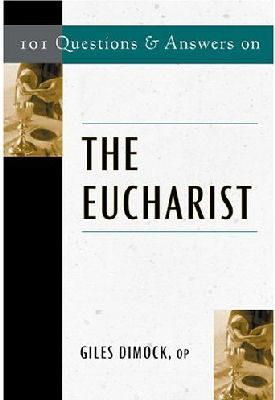
|
Posted July 19, 2006
Book: 101 Questions & Answers on The Eucharist Author: Giles Dimock, OP Paulist Press. New York. 2006. Pp. 139 An Excerpt from the Jacket:
- Historical - Theological - Liturgical - Spiritual Beginning with the Jewish background of eucharistia, or giving thanks, in the setting of the communal and sacrificial Passover celebration, the author examines the theology of the Last Supper in the light of the paschal mystery. 101 Questions & Answers on the Eucharist deals with transubstantiation, sacrifice, real presence, communion, intercommunion, and many more subjects, from a practical and ecumenical perspective. Conciliar and papal documentation are the author's context for many of the responses and teaching on the Eucharist. An Excerpt from the Book: Why do we have so many Eucharistic Prayers? For centuries the Roman Canon (Eucharistic Prayer I) was the only prayer in the Roman Rite. After Vatican II, when the liturgy was being officially reformed, many liturgists asked to have some other possibilities, either some of the great Eucharistic Prayers from other liturgical traditions or new ones modeled after ancient prayers, such as those of Sts. Basil, James, John Chrysostom, and others. So other prayers were added to the first Eucharistic Prayer. Now we have: Eucharistic Prayer I or the Roman Canon: This prayer is mentioned by St. Ambrose in his De Sacramentis and is therefore very ancient. It is in the Alexandrian tradition of having intercession before and after the Words of Institution. It is Roman in its sobriety, its gravity, and its lists of Roman martyrs or those saints who were popular with Roman people. This prayer heavily emphasizes the sacrificial dimensions of the Eucharist. It is recommended for special seasons and occasions, especially when there are proper parts. Eucharistic Prayer II: This is basicially the Eucharistic Prayer that St. Hippolytus composed as a model for others. It is brief and concise, and since it was edited for contemporary usage, the Sanctus was added because the original text was bereft of that acclamation. Also, as the early Church was being led to deeper understanding as to the ramifications of who Christ was, the Holy Spirit helped to crystallize formulas that were precise. The text of St. Hippolytus lacked some of that precision and seemed a bit Adoptionist, and that lack was corrected in our contemporary text. This prayer is designed for daily use. Eucharistic Prayer III: This is a contemporary composition in the light of ancient variants from the Galliean and Hispanic traditions. This prayer is recommended for Sundays and funerals (because of the special part for the dead). Eucharistic Prayer IV: This prayer is modeled after that of St. Basil, who recounted all of salvation history in his prayer. This does the same (though not in as great detail as did he) both before and after the Sanctus. When first issued, it was recommended for those with the biblical culture to understand it, but that no longer seems to be the case. It's probably too long pastorally to be used in parishes for daily Mass. It is that prayer in the Roman Rite that helps us to breathe "with both lungs" as Pope John Paul would have had us Latins do. Two prayers of reconciliation were introduced under Pope Paul VI for the Holy Year of 1975. They are appropriate during Lent, times of war or strife, or when prayers for unity are called for. Three prayers for Masses with children use a simpler style of language while trying to avoid the childish and yet bringing the children's participation in more to capture and hold their attention. The four Eucharistic Prayers for Various Needs and Occasions have four different themes: the Church on the way to unity. God guides the Church on the way to salvation. Jesus the way to the Father, and Jesus the Compassion of God. The Roman Missal suggests occasions when these prayers would be appropriate. Table of Contents: 1. Jewish background: beginnings 2. Names of the Eucharist 3. The structure of the Eucharistic litrugy of the Mass 4. The sacrifice of the mass 5. Christ's presence in the Eucharist 6. Communing with Christ in the Eucharist 7. Eucharistic reservation and adoration 8. The architecture and vessels of Eucharistic reservation 9. Eucharistic spirituality 10. The saints of the Eucharist 11. The eschatological dimension of the Eucharist |
|
